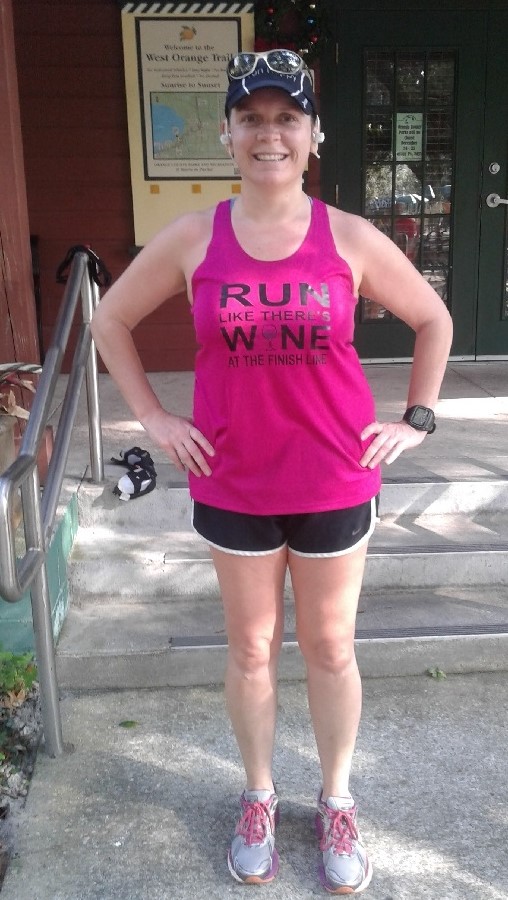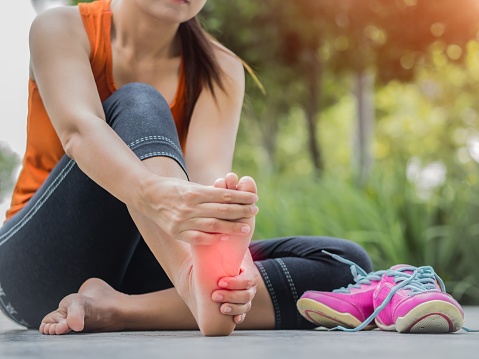A Wine-Loving Runner's Blog

From Plantar Fasciitis to Half Marathons and Olympic Triathlons: A Wine-Loving Runner's Blog
I am not much of a writer and I have never had a blog before, but I thought I would give it a try and share some of my journey with you all!
I really started running in my late 20s – I had run before of course, but I was never much of a “runner” as I was a “walker who could run a fast mile once a week in high school”. I did my first full marathon at 28 and have continued to love (hurt?) my body into my early 40s. (40! Is that really the number here?!). When I started becoming a “runner”, I didn’t have much information about how to do so in a healthy for my body way nor did I do the research to make sure I was doing so – I just ran! I didn’t pay attention to the chapter in my The Non-Runner’s Marathon Trainer book. (Great book! Maybe a little outdated, so do your research, but it really did work to take a non-runner to running my first marathon.) Here is a link if you want to check it out: https://amzn.to/3tnQZUG
As I was saying, I didn’t pay much attention to the chapter in the book that talked about strength training for running. I did some of the upper body workouts, but I thought to myself, “I’m already working out my legs by running, why do I need to do strength training on them, too?”. Wrong! Cue knee and hip and who knows how many other injuries and hours of physical therapy to finally get the picture.
My journey continues through months (and sometimes nearly years) of not being able to run due to injuries (more on those later including tips and remedies), and my goal with this blog is to share that journey along with things I learned along the way that helped me. At this writing, I am (still) in my early 40s and (still) running half marathons and competing in Olympic-distance triathlons. You need to LOVE the body you have and TAKE CARE OF IT along the way! Please enjoy! Feel free to contact me with any suggestions or questions!
(Note: I am not a medical professional, so the tips below are based on my own research and information from doctors I have worked with)

Finding Relief: Top 10 Remedies for Runners with Plantar Fasciitis
Plantar fasciitis can be a daunting adversary for runners, causing pain and discomfort in the heel and bottom of the foot. For those passionate about pounding the pavement or hitting the trails, this common ailment can put a significant hitch in your stride. However, there are remedies and practices that can alleviate symptoms and aid in the recovery process.
Here are some top remedies for runners battling plantar fasciitis:
Rest and Ice: One of the fundamental steps in healing from plantar fasciitis is giving your feet ample rest. Reducing or temporarily halting running activities can help alleviate strain on the inflamed tissue. Additionally, icing the affected area for 15-20 minutes several times a day can help decrease inflammation and ease discomfort.
Proper Footwear: Invest in supportive, well-fitted shoes designed for running. Shoes with adequate arch support and cushioning can help distribute pressure more evenly across your feet, reducing strain on the plantar fascia. Your local running store can help you find the right pair for you. Personally, I love my Diadora shoes.
Stretching and Strengthening Exercises: Regular stretching of the calf muscles and Achilles tendon can alleviate tension on the plantar fascia. Incorporating exercises that strengthen the muscles in your feet and calves can also provide added support to the affected area. (Calf raises are a MUST!)
Orthotic Inserts: Consider using orthotic inserts or arch supports prescribed by a podiatrist or recommended by a reputable source. These inserts can provide additional support and cushioning, reducing strain on the plantar fascia while running.
Physical Therapy: A physical therapist can guide you through exercises and techniques to alleviate pain, improve flexibility, and strengthen the foot muscles. They may also utilize modalities like ultrasound or massage to help with healing. (If you are in the Tampa/Sarasota area, my doctor was Dr. Andrew Wengert at Veracity Soft Tissue + Spine – he was the ONLY person who was able to get me running again!)
Night Splints: Wearing night splints can help stretch the plantar fascia and calf muscles overnight, reducing morning pain and stiffness.
Reducing Impact Activities: While healing, consider cross-training with low-impact activities such as swimming or cycling to maintain fitness without exacerbating the condition. This one is maybe the HARDEST to follow, but it may be one of the most important. Try to resist the urge to return to the road too soon. (See #9 below)
Anti-Inflammatory Medications: Over-the-counter medications like ibuprofen or naproxen can help manage pain and reduce inflammation. However, consult a healthcare professional before prolonged use.
Gradual Return to Running: Once symptoms subside, gradually reintroduce running into your routine. Start with shorter distances at a slower pace and pay attention to any signs of discomfort.
Consulting a Healthcare Professional: If the pain persists or worsens despite trying these remedies, it’s crucial to seek advice from a healthcare professional. They can provide a tailored treatment plan or suggest advanced interventions if necessary.
Remember, consistency and patience are key when dealing with plantar fasciitis. Every individual may respond differently to treatments, so it’s essential to find what works best for you. By combining these remedies and making necessary adjustments to your routine, runners can often manage and overcome plantar fasciitis, allowing them to lace up their running shoes with greater comfort and confidence.